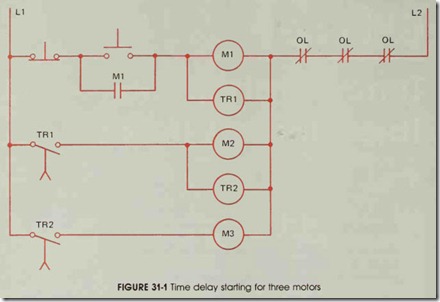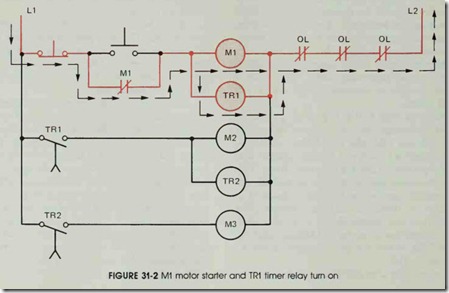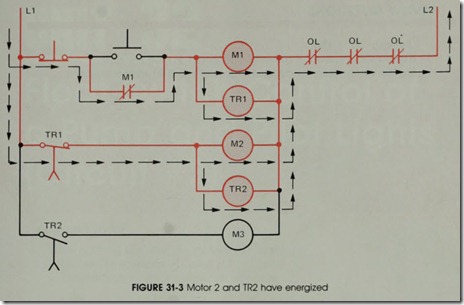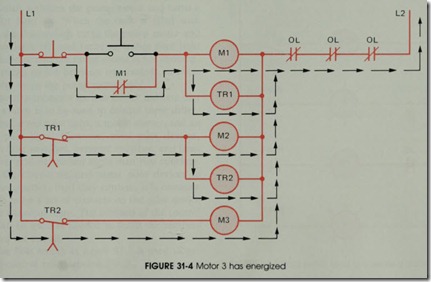Objectives
After studying this unit, the student will be able to:
• Discuss the operation of circuit #2
• Troubleshoot circuit #2 using the schematic
A machine contains three large motors. The current surge to start all three motors at the same time is too great for the system. Therefore, when the machine is to be started, there must be a delay of 10 seconds between the starting of each motor. The circuit shown in figure 31-1 is a start-stop, push-button control which controls three motor starters and two time-delay relays. The circuit is designed so that an overload on any motor will stop all motors.
When the start button is pressed, a circuit is completed through the start button, M1 motor starter coil, and TR1 relay coil. When coil M1 en ergizes, motor # 1 starts and auxiliary contact M 1, which is parallel to the start button, closes. This contact maintains the current flow through the cir cuit when the start button is released, figure 31-2.
After a 10-second interval, contact TR1 closes. When this contact closes, a circuit is com pleted through motor starter coil M2 and timer re lay coil TR2. When coil M2 energizes, motor #2 starts, figure 31-3.
Ten seconds after coil TR2 energizes, contact TR2 closes. When this contact closes, a circuit is completed to motor starter coil M3, which causes motor #3 to start, figure 31-4.
If the stop button is pressed, the circuit to
coils M 1 and TR 1 is broken. When motor starter M1 de-energizes, motor # 1 stops and auxiliary contact M1 opens. TR1 is an on-delay relay; therefore, when coil TR1 is de-energized, contact TR1 opens immediately.
When contact TR1 opens, motor starter M2 de-energizes, which stops motor #2, and coil TR2 de-energizes. Since TR2 is an on-delay relay, con tact TR2 opens immediately. This breaks the cir cuit to motor starter M3. When motor starter M3 de-energizes, motor #3 stops. Although it takes several seconds to explain what happens when the stop button is pressed, the action of the relays is almost instantaneous. If one of the overload con tacts opens while the circuit is energized, the ef fect is the same as pressing the stop button. After the circuit stops, all contacts return to their nor mal positions and the circuit is the same as the original circuit shown in figure 31- 1.
REVIEW QUESTIONS
(Refer to circuit 31-1.)
1. Explain the operation of circuit 31-1 if contact M1 did not close.
2. Explain the operation of circuit 31-1 if relay coil TR2 were burned out.



